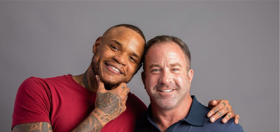
Transgender people are regularly evicted from their homes, fired from their jobs, and denied medical treatment. Last July, emergency room staff in an Indiana hospital refused to help a trans woman who was coughing up blood, referring to her as “it.” More than a quarter of transgender people surveyed say they have lost a job because of discrimination. Transgender people are more likely to become homeless (at an average age of 13, in New York City). And then there is the obstacle course of inconveniences that reminds transgender people every day that they don’t belong. One trans woman told me her company requires her to lock herself in when she uses the restroom—even though it’s multi-occupancy—so she is acutely aware of making other women wait. In some states, a court order is required to change a person’s gender on a driver’s license. Many health insurance plans only cover procedures for one gender, so a person born male who transitions to female can’t get both a prostate check and a mammogram.
But these are statistics, and people are rarely moved by statistics. In this country, civil rights movements have prevailed when they have convinced enough people that a minority is being treated in a way that is fundamentally un-American. For this to happen, people need to see members of a disadvantaged group as human beings before anything else. The gay rights movement, for instance, has made great strides in large part because increasing numbers of people know, or are related to, an openly gay person. For more and more people, gays and lesbians do not seem strange—but the idea of denying them rights does. Such a breakthrough seems unlikely for the transgender movement. According to the Williams Institute at the UCLA School of Law, there are only around 700,000 transgender people in the United States, compared with around eight million gay, lesbian, and bisexual people. They are invisible in a way that other minorities are not.
At some subterranean level, transgender people provoke deep fear and hostility in our culture. They complicate categories that many people would prefer to think of as fixed. One might think that, as the gay rights movement has advanced, transgender people would share equally in its gains. But, in fact, the mainstreaming of the gay rights cause has created tensions between the two movements, and at times the transgender community has been pushed aside. Transgender people clearly need more protection from our laws and society. But they can’t win these victories on their own. Like every minority group at the outset of a civil rights campaign, they will need the rest of us to take the time to understand their lives—and maybe even try to imagine ourselves in their shoes.
– Eliza Gray in her must-read piece for The New Republic entitled “Transitions: What will it take for America to accept transgender people for who they really are?” Her beautifully-written article also includes a complete history of trans rights and exclusion in the LGBT community. Well worth your time.



















jimstoic
The thing that has most changed how gay and lesbian people are viewed is our visibility on a personal level. Most people know someone gay or lesbian. Not as many people know transgender people.
xande65
This is a really well written piece. It’s true, that the transgender community has a lot to fight for in America and in other places around the world. However, like Ms. Gray says, we are only an even smaller percentage compared to the small percentage of LGB people. We also face hostilities even from within that same community. I myself, a gay trans-man, have been berated by gay cisgender guys who called me a “desperate fag hag” and said that I’ll never be a “real” guy. That really hurt. But even though I faced that, I’m not resentful of the community. I’m very proud to be part of the LGBT. It’s not about turning on each other and leaving each other to fend for themselves. We want to help people to understand our situation better. We want other people to understand us better. I’m not saying that the LGB community should do all the work for us. But as I said, isn’t it better when we all band together to help each other out? If we do that, I’m sure we can achieve great things.
lemon-lime
Why do trans women need mammograms?
Laughriotgirl
@lemon-lime: we have breasts…
missanthrope
@lemon-lime:
We have breasts, and sometimes those breasts grow tumors, just like with other women.
As for the main article, I would say that we’re ten to fifteen years behind in media representation, but probably twenty to twenty-five years behind when it comes down to real life discrimination and being economically disadvantaged because of job discrimination.
Jeffree
Thanks Queerty & Daniel V. for highlighting the article. As said, it’s well worth a read. When one hears about the emotional, social, political & finançial toll of people’s transitions, it’s an eye-opener & a wake-up call. We in the LGB portion of the Queer umbrella too often forget about the T.
If we LGB folks marginalize our Trans sisters & brothers, we do so at our own peril: we share common interests & goals and face many of the same enemies. Even if our “to do” list isn’t identical, there are lots of areas where we match up.
I’m no saint; I’ve made more than my fair share of ignorant & phobic comments, but my patient T allies have called me out on them, schooled me, & not given up on me. More than one trans comic has been “inspired” by my gaffes. When you hear a bit that starts with “Why do gay guys insist on ___” it could be about me.
Talk about courage & strength: as someone reminded me, many trans people don’t make it to OR survive the transition, they end up dead by their own hands or someone else’s.
It’s time for us LGB folks to do more listening & less assuming.
lemon-lime
@Laughriotgirl: @missanthrope: Cool. You learn something new every day, I guess. I guess it’s because of the hormone therapy.
Thomas M.
“It’s time for us LGB folks to do more listening & less assuming.”
No, it is time for LGB folks to stop lying to themselves and telling themselves that they are inextricably and definitionally linked to transsexuals and cross-dressers. That is a lie. It is an ancient lie that we fought for decades before some fools thought that it would be progressive to redefine us as “queer” and tell the world that gay men and lesbians are at war with their gender. It also hurts transsexuals to tell them that they are not real men or women, but that they are, in a way, like gay men in dresses or lesbians in suits. The entire concept is a lie borne of ideology and it has been a disaster.
We have very few common interests with trans people. Where those common interests exist, I have no problem teaming up with them as political allies to get some goal accomplished – if it makes sense to do so on a case by case basis. But this nonsense of putting letters together and redefining ourselves as LGBT is deceitful and, IMO, morally wrong.
Cecilot
Most people, even people who are a part of the gay community, just don’t realize that we have to fear for our lives every time we go out of the house. In challenging gender we also challenge sexuality because a lot of people assume that MTF’s will fall for men and FTM’s will fall for women, but if we do not then we chance being shunned by the gay community on top of already being shunned by everyone else. I wake up every day wondering if people will figure it all out, that I was not born with all the male bits an pieces. Every morning I wonder if I am going to be fired or beaten or shot. I didn’t think anything of it until lately, but it is frightening to think that I have accepted that I will be beaten up and cussed out. Honestly, at this point I don’t expect to make it to 40, because at some point someone will probably kill me because they can’t get around gender.
Laughriotgirl
“Angie Zapata, an 18-year-old Colorado woman, was bludgeoned to death with a fire extinguisher when her attacker—a man she met through a social-networking site—realized that she was born male.”
While this is a great article, this quoted portion is a problem as it conforms to the “deceptive transsexual” trope – the idea that trans women “trick” unsuspecting straight men into sex. The man is then justified in his actions by his horror at this revelation.
Since this was Ms. Zapata’s killer’s defense, and based on testimony and his conviction, this was not the case.
Jeffree
When I came out as a gay man, that was tough, even if I did so under pretty ideal circumstances: non-religious, non-homophobic family, and not the first member of the crew to come out.
My coming out didn’t require a doctor to certify that I am “officially” gay, I didn’t need to change my name, my drivers license, passport, birth certificate, or wardrobe [ok, I did get better fitting jeans!], I didn’t need to get surgery, take hormones or worry about which restroom to use.
So, when I hear about what trans people go through, I can’t help but want to be an ally when, where, how I can.
When the phone rings at 3 a,m. & my friend R. has lost her job or apartmënt because of somebody else couldn’t bear working or living with her, I will answer, make coffee, & we will find her someplace else. If the situations were reversed, she would do that for me. She may have to someday.
That’s not me being “politically correct”; that’s me responding to a fellow human being.
Evan
Daniel – just want to say that I love that you’re writing on trans issues so much these last couple days 🙂
– Evan/kyril
Hal Shipman
Wait, what?
“According to the Williams Institute at the UCLA School of Law, there are only around 700,000 transgender people in the United States, compared with around eight million gay, lesbian, and bisexual people.”
There’s an 8 to 1 ratio of gay/lesbian/bi folks to transfolks?
Wow.
Fitz
It seems like in movies, if they ever have a tranny, they are seriel killers or clowns.
Jeffree
@Hal Shipman: I sure wonder about that statistic too.*
If somebody has other data, please share.
*Clearly, the nomenclature alone will influence the reported number. Given that even the # of LGB people still is uncertain, and different survey methods produce very different results, I have to question if we’re any closer to a valid data point with Trans people.
Prima Facie
It’s great knowing the statistics are so slanted against us trans folk that we damn near have to accept that we are going to get a beating. It’s not like we haven’t paid the fucking piper time and time again. It’s a shame that any time I go out to just hit up a bar i gotta make sure I carry a handgun not in the offchance but with some sense of certainty that my life will be threatened.
Thomas M.
Absolutely no way are there 700,000 trans people in the US. Their largest event – a national event – drew about 100 people. Their 3 largest national organizations have a combined budget of $1.4 million. If their 3 top national groups pooled all their resources, they would have just enough to make a nice indie film.
BTW, note that these trannies have trans-only organizations and that, as pitiful as their budgets are, they represent funds dedicated solely to trans issues. If a gay group attempted the same thing, a bunch of braying, drooling fascists would be denouncing them as “transphobes”.
I suppose you could manipulate the numbers by asking about any straight guy who ever got off wearing panties even once in his life, but the broader you define “transgender” the less significance it has in terms of a social or political identity.
Jeffree
@Thomas M.: You have opinions, you have thoughts, but your grasp of data seems tenuous at best. Conflating budget with membership is the least of your stat errors: perhaps you need a refresher c0urse on how to count?
I look forward to your keen reasoning on matters such as people allergic to pollen, type 2 diabetics, & the incidence of blue/green color blindness.
Dee Omally
As a female with trans* history, I sat down and typed a lengthy “State of Transgender Affairs” that might be good read….kinda long though
http://transendgender.wordpress.com/2011/06/27/the-state-of-the-transgender-union-in-2011/
I think it is a rather thorough job detailing where we are and where we need to go.
Luv, All
oh…one good thing that has changed is as a veteran who 27 years after discharge signed up for non-service connected med insurance, when I checked into my first med/lab work visit, my NP wouldn’t authorize hormone levels to be checked. The pass bucking had begun as she referred me to West LA VA who replied “we don’t do TG”…(who by now prob realizes that as of June 10 they better start “doing TGs”)…so today I got a call from the original clinic asking me to go in for hormone blood level checks! Whoopee doopee do da day I say! Thinks R looking up!
SteveC
Why is the trans movement 20 year behind the LGB movement?
1. Numbers – there are simply not as many trans people as there are LGB people, therefore less visible.
2. The inability of the trans movement to get over its internal differences. This is also true of the LGB movement where there is a lot of infighting. But from what I can see the LGB movements are better able to put aside their differences and present a unified front when needed. Any debate about trans issues (on here or on other sites) almost immediately descends into a brawl – with transsexual people hating on transgender people hating on intersex people hating on genderqueer people. And all of them reacting in a very nasty manner to anyone who asks well-meaning but perhaps uninformed questions. I have no idea about whether my experience is typical but because my knowledge of trans issues is limited, I often need to ask questions. I ask these questions with a genuine desire to understand their issues but usually regret even asking due to the accusations of being transphobic or cis-sexist or being caught up in a hetero-normative gender binary or something. This type of reaction really doesn’t inspire me to get involved.
3. The women’s movement. I think it’s accepted that M2F trans people are the most vulnerable to violence, poverty and discrmination among the trans community. I rarely if ever see the women’s / feminist movement step up, and adopt this cause as a women’s issue. Surely the M2F trans community should be demanding that the feminist movement adopt their struggle as quite often the LGB movement cannot fulfil this function properly.
Cam
Why is the gay movement 30 years behind the civil rights movement?
Visibility. The gay movement was dependent on people coming out. For the civil rights movement minorities were visible. Gays had to wait until there were a larger group of out people.
Renee Richards came out years ago as transgendered, now they are gaining visibility just like the gay community did.
Mike in Asheville
@Hal Shipman: 700,000 to 8,000,000 = 1 to 11.4
Is it really a surprise? When out in the gay ghettos (bars/restaurants/shops in gayborhoods), it would seem much less than that, though, as pointed out by many, many trans are not gay and live a quiet private life.
Mike in Asheville
My first exposure to the notion of transsexualism came at the breakfast table. While in jr/sr highschool, our family most mornings enjoyed sharing breakfrast before heading out to school for the kids, dad to work, and mom to college. That was 1975-1980.
And every such morning, my dad would read aloud “Tales of the City” complete with Anna Madrigal, or, as we found out later in the TV version, “Anna Madrigal” = “a man and a girl”
*******************
[Not a member of New Republic, so I read but just the 1st page, and of course, what was reposted here]
But, for such a question, in the first several opening paragraphs, and not even a mention of HIV/AIDS?
Because of HIV/AIDS, tens of thousands gay men, and many many many supporting lesbians, forced our public exposure: we are not freaks, there is a virus killing us off (over 100 gay men died EACH FUCKING DAY 1993-1995), and since you, government/social support, say “let them die” we took to the streets, took to Congress, took to the CDC/NIH, took on big city governments, etc.
HIV/AIDS also spurred story lines in everyday TV shows and a handful of primetime network TV movies (remember, waaay back then, there were still but 20-30 channels available on cable, so concentration of audience was higher).
I AM NOT pulling one of those notions from anti-gay pro-racial-civil-rights types that we gays/lesbians have not endured enough, as black Americans have suffered, to earn our rights bullshit arguments. The struggle, internal and external, of transsexuals is beyond my experience.
I am saying, I don’t know what to make of an article comparing the last 30 years of civil rights campaigns of gays/lesbians and transsexuals without taking into account the HIV/AIDS crisis.
Daez
@Jeffree: Yes budgets have nothing to do with memberships. Its not like members don’t raise money for the organization. Its not like members don’t donate member to the organization. I can totally see how the two have absolutely nothing in common. *GROANS!*
evanb
@Thomas M.: No, it is time for LGB folks to stop … telling themselves that they are inextricably and definitionally linked to transsexuals and cross-dressers. That is a lie. …We have very few common interests with trans people. Where those common interests exist, I have no problem teaming up with them as political allies to get some goal accomplished – if it makes sense to do so on a case by case basis. But this nonsense of putting letters together and redefining ourselves as LGBT is deceitful and, IMO, morally wrong.”
At the risk of inciting all manner of hate, I couldn’t agree more. There are fundamental differences in the challenges faced by gay and trans people, and to lump us all together because of some superficial similarities and erroneous assumptions is, in my opinion, what holds both communities back. I am a man who is sexually attracted to other men. I am not a straight woman trapped in a man’s body. I have no more in common with a straight woman who is trapped in a man’s body than I do with a straight biological woman. I fail to see the nexus of interest between gay men and lesbians on the one hand, and people who seek hormone treatment and surgery to accomodate themselves to their true place in heterosexual society. (OK some trans folk are gay too, and that’s layers on layers of trouble for them.) Our political fights are not the same just because we both face discrimination and violence that has “something to do with” sex. Combining us all together confuses the issues and perpetuates myths that do no one any good.
Mike in Asheville
@Thomas M.: @evanb:
We are only as strong as the weakest link.
Indeed the socio/political and sexual identity differences between the gays/lesbians and transsexuals are significant, varied, and different.
Nonetheless, the civil and social rights of gays and lesbians WILL BE stronger, more durable, and fully expanded WHEN transsexuals too achieve their rights of equality and nondiscrimination.
What we share with transsexuals is oppression from the majority; working with all oppressed because their sexual identity helps all who are oppressed because of their sexuality.
Sweetbrandigirl2004
Steve all your reason are good ones and if I may I will expound on them just a bit.
1) The shear numbers of Gays & Lesbians way out numbers ALL of the gender variant people regardless of what group they consider themselves part of, with gay & Lesbians numbering around 8 million they are a considerable voting block.
2 MONEY thats right there are a number of very wealthy gay men who have supported Gay laws and bills with huge donations. How do you think NY Bill got passed it was money, you didn’t think the GOP Senate had an epiphany and just decided to do the right thing did you ? The Trans movement doesn’t have that kind of money and thus they can’t move things along in the same fashion.
http://www.huffingtonpost.com/2011/06/27/money-gay-marriage-bill-new-york_n_885546.html
3) The UMBRELLA concept will be the death of the trams movement, it is at the root of the Infighting and is the cause of the bitterness and distrust that is exist now. The Transsexuals can’t stand the transgender and are justifiably upset that their diagnosis has been co-oped by the Transgender as vilification for they’re way of live. Likewise the Transgender refuse to let the Transsexuals out from under their Umbrella knowing that if they do they will have NO legitimate medical condition to justify their existence, this is another source of discontent between the two groups. So far the trans movement has rode the coattails of the Gay movement achieving minor gains for ever major gain made by the gay community. I feel this trend will end once DOMA falls on a national level and with DADT in its final stages once it’s complete the gay agenda will have little to work on except for fighting against the state that refuse the fall of DOMA. Meanwhile the trans movement will be on its own and with little money and small numbers they aren’t like;y to get any of their issue addressed or passed into law.
Sweetbrandigirl2004
I also agree that the transgender have nothing in common with Gays and Lesbians other then both are discriminated against but that can be said of blacks and jews and a variety of other groups who also face discrimination. There are differences between the variety of groups that are considered part of the umbrella from the transgender, to gender queer to the cross dresser to the transvestites and even the transsexual who don’t wish to be a part of the umbrella all have different needs and wants and interest. With all these differences theres no way they will ever agreed on anything long enough to unite and get anything accomplished.
Ginasf
@Hal Shipman:
Hal, I don’t know if you think 700,000 is a lot or a little, but if you read the methodology of the Williams Institute study you’ll very quickly see it’s a vague guesstimate based on 3-4 other very flagmentary studies. Don’t take that number too seriously.
Jeffree
@Brandi: Some of what you said actually made sense..Progress is good. (I didn’t get the part about the trams, because I’m mostly a bus or train kind of guy!)
What are your thoughts on GENDA?
Jeffree
@Ginasf: Thanks for the info on the Williams Institute. Are there other numbers out there? My quick try at the Gooogles didn’t yield much. Do you think the 700K number is too high or low?
@Mike in Asheville: The Trans population deals with HIV/A.I.D.S. also.
Sweetbrandigirl2004
@Jeffree: HAHAHA you’re so funny you really shouldn’t be here online you should be onstage doing comedy your almost as funny as Tracy Morgan. I’m sure you known what I meant and if not oh boy that speaks volumes about you.
As for the 700,000 number even if there are that many trans in the U.S I’m betting that ever gender variant person of any kind Transsexuals, transgender, cross dresser, transvestite, gender queer you name it. All together they don’t make a large enough force to get anything done and that’s IF they could ever get organized and agree long enough to present a united front ,which they can’t
missanthrope
@Thomas M.:
“Absolutely no way are there 700,000 trans people in the US. Their largest event – a national event – drew about 100 people.”
Really? Where do you get those figures? I believe that the Southern Comfort Conference draws about 1000 annually. The Philidelphia Tran Health Conference has about 300-500 annually.
I was at Trans March SF last year and there were about 1000 people there, at least 2/3rd were trans of some stripe.
Have you’ve actually attended a trans event or do you actually have facts to back up your claims.
Fitz
I think a lot of people probably know someone who is
Trans, but don’t know that they are Trans.. I think
us non-trans folk just notice the ones who are either in
transition or who aren’t so lucky with the natural attributes.
It’s outrageous that a medical professional would deny someone ER care. And it’s illegal under EMTALA.
As a medical professional myself, I strongly encourage anyone who has experienced this to “nail them to the wall”.
Danielle
@lemon-lime: And, you would be right. Hormone therapy doesn’t result in “fake” breasts (they’re not silicon, honey!), but the same breasts that are on cisgendered women the world over. Unlike most cisgendered women, though, they grow REALLY fast. For many, it takes about 4 years for full breast maturity. For the trans-girl, it takes about half that (with the right HRT regimen). For those of us in our later years, that could spell disaster in the form of breast cancer. So, mammograms are a necessity. On the other hand, there are certain medications, like Premarin, that increase the risk of certain cancers, like breast cancer. So, hormone therapy has a few more benefits and dangers than most people realize. And, now, you’ve learned more, today. Go you!
Danielle
@SteveC: Feel free to ask any questions without being judged. My email is provided. I’d be more than happy to speak about this.
1. We also don’t have nearly as much money. Due to the high cost of transition (because insurance doesn’t cover it) and the high rate of unemployment (because of discrimination), we just don’t have the funds that many others in the LGB organizations have. Therefore, we’re at a heavy disadvantage. It’s not just about numbers in the population, it’s all so about how many zeros are behind that dollar sign ($).
2. I have expressed a disdain for that sort of behavior, as well. Seriously, it does nothing but create a rift in the community when we’re already outnumbered. We need to stick together and unite… or we’re really screwed.
3. Well, for this, you should take a look at Janice Raymond’s book “Transsexual Empire” (published in 1979) for explanation. To them, we are not wanted and the book explains their reasoning and ideology. It’s been causing a rift between transgendered people and the “Womyn’s Movement” since that publication.
Thomas M.
@Mike in Ashville:
That is basically an argument for a political alliance, to which I already have said I have no objection. But in an alliance, you always retain your right to say no, to consider whether and to what extent you should sacrifice for your ally, to consider what you are getting out of the deal, and to consider whether and when it is time to call an end to it. It also doesn’t require you to change your very identity. LGBT, on the other hand, creates a completely fictitious singular “community.” This has 2 pernicious effects. First, it sends a false and harmful message to gay youth and to trans youth, as it tells the former that they are are not fully boys and girls, but instead are in conflict with their genders; it tells trans kids that they are not truly the gender with which they identify, but in some sense are kind of like gays or drag queens or drag kings. This is foul, IMO.
Second, it takes away the ability of gays and lesbians to consider their own interests. By creating a fictitious community, Ts are not in a position of asking for help from an ally, but in demanding sacrifice from their “family.”
Believe me, if one of our allies – say the teachers’ unions or NARAL – had asked us to incorporate into ENDA some provision relating to teacher pay or abortion that would have killed the bill, we would have politely told them that, while they are good allies and we will help them on their issues in other ways, we can’t sacrifice our primary legislative goal for them. We would never do it. But thanks to LGBT, trans activists don’t have to ask and we are not allowed to consider what makes sense. We have to do what they demand or we are betraying a member of “our community,” throwing them under the bus, etc. That is the con game that prompted the concoction of LGBT in the first place.
@Missanthrope:
I have both witnessed national trans gatherings and have viewed online video of different events represented as national in scope. In these instances, I counted about 100 people, some of whom were media and/or not readily identifiable as trans. What are the sources of your numbers? In any event, even taking your numbers as accurate – 300 on the low end, around 660 trans attendees for the march and 1000 for the southern conference (of which some portion presumably are not trans), they are still extraordinarily low, especially when you consider that these are established events with some notoriety.
Jeffree
@Danielle; @Missanthrope,: Thanks for the info & insights you provided. You probably get tired of having to explain things for the 400th time, but what you say does matter.
I appreciate your helping this site become more of an diverse online community & less of a cyber frat-house for gay “dudes,” where there’s stale e-beer & mismatched e-socks all over the place!
@Brandi: You’re welcome to attend any of my IRL performances. I do get good reviews but it’s a hobby more than anything else. Mostly I write for other people (some comics do buy material, the ones who steal it get slammed by their peers but it still happens). When you get invited back, that’s always a good sign.
Danielle
@Thomas: I have some choice words for you, sir, but I’m too much of a lady to repeat them on this forum.
OUR rights are detrimental to YOURS? By saying that, you ARE throwing us under the bus, just like the “Gay & Lesbian” movement has done since WE threw the first beer bottles at Stonewall! If not for us, then you wouldn’t have your precious movement! Explain to me how it’s still legal for employers to fire someone based on “sexual orientation” in just 29 states, but for “gender identity and/or expression” it’s still legal in 36! The whole attitude of the “Gay & Lesbian” crowd has been, “Look, you trannies, let us get our stuff passed, then we’ll come back for you.” Okay, so when are these seven states going to add us to their non-discrimination laws?!
Whether you like it or not, we’re in this together. The real reason that anyone is getting fired for their “sexual orientation” isn’t that their boss caught them at the club snogging with their boyfriend/girlfriend. They got fired because they dress and/or act “like a woman/man”. You’ve got the flaming twink with limp wrists and the butch dyke with short hair. That’s “gender expression”, plain and simple. If you can’t see that, would you please remove your rose-colored glasses?!
Have you even considered that much of the lack of representation at “national” events is that most of us don’t have the money to make a trip to D.C. on a whim? We’re too busy trying to hide in the closet of “stealth” so we can keep our jobs to worry about that kind of thing. That’s what happens when you’re disproportionately oppressed!
@Jeffree: Thanks for having us over. Happy to add a woman’s touch to the place. Be a doll and pass me a beer, would you?
Dieks
The title of the OP is…. “Why Is The Trans-Rights Movement 20+ Years Behind The LGB Movement?”
My question is why is the Trans-Rights Movement co-opting every single minority, civil, equality movement… women, lesbians, gay men, bisexuals, inter-sexed, poc and physically challenged?
It’s taken millenniums for each of these individual groups…. w/a LOT less publicity, access and actual LAWS, medical industry working against them to have come as far as they have.
“Transgender people are regularly evicted from their homes, fired from their jobs, and denied medical treatment.”
NONE of the regularly co-opted above individual groups have true equality. Not to mention that HALF THE POPULATION of the ENTIRE WORLD… still does not have equality.
They suffer poverty, are paid less, work more, 50% of that number are parenting alone and the topper::
Half the population… a woman is raped every MINUTE here in the US.
Half the population… 25% of THAT number has been victims of physical violence
Half the population… is murdered at a minimum of 3times a day in the US.
Half the population are denied jobs.
Half the population are denied housing due to a million different reasons… but all come back to some aspect of being a woman.
Half the population is being denied medical treatment due to poverty AND laws to govern our bodies as women.
So the 20+ years the Trans-Rights Movement is “behind” LGB’s? Yet over and over and over again on this site, other blogs and sites… the TG/TS movement holds the LGB’s responsible for THEIR movement. The narcissism is overwhelming.
Half the population is a little busy surviving w/our own freaking equality because after we were slapped on the ass, thrown into a pink blanket and they yelled… “IT’S A GIRL!”
It’s been SOLELY half the populations responsibility to stop engaging in gender bullshit.
Laughriotgirl
@Danielle:
LGB and T are not allies. we could be, we should be, but we are not. At some point we because automatically the same thing (or close enough to be essentially the same). Because of this relationship, can we honestly say that LGBT has been beneficial to trans women (Trans men may have a different perspective, so I’m not talking about them)? Because we are “the same” we run into issues like NH where one group’s basic protections are traded for the “greater good” of marriage equality and the larger population feels justified in being confused or upset when the ones traded are angry.
In an ally relationship, groups work together on issues that make sense and don’t on issues that seem out of scope. In an ally relationship, one group does not have the authority to bargain away inclusion of the other. One group cannot be used to stall legislation for the other either.
Let’s take NY this past few months. We had two bills, both had trouble getting out of committee. One got massive public attention, the other got nothing (literally zero). Was it wise for the state-level groups to push two bills at the same time? Was one bill essentially traded as part of the compromise that got the other passed? This doesn’t happen among allied communities. That can only happen within the same community.
It is essentially the difference between “friends” and “family”. Friends help because they like you, family because they have to.
Considering that trans legislation started roughly 10 (maybe 15) years before Stonewall and we have the most basic recognition in 47 states, all through legislative actions and not Executive policy or Judicial determinations – I think the fact we can say “trans rights are 20 years behind…” is telling. But not in the way lots of people think.
There are clear areas of overlap in the LGB and T. If nothing else most trans folks are moving into or out of the LGB during transition, so there are connections and friendships and (hopefully) understanding. We have issues of violence that also resonate with feminism – specifically, violence against GL people is less about who they love and more punishment for not being the “right kind” of man/woman. Trans attackers tend to be intimate partners or friends rather than random thugs on the street. In this, it dovetails into Domestic/Partner violence…)
If trans folks had our own movement, I think we would be better served. We wouldn’t have to support groups or individuals that have wronged us in the past (LGB and Straight). We would be able to control the message – heck, we’d be able to have a message that was a footnote on the end of a donation drive. We would be included in discussions of laws that actually affect us.
The question, IMO, has our being enfolded by the “LGBT” (and make no mistake the LGB and T have both benefited at the expense of the other) gutted a trans-specific movement to the point we will have to spend the next decade doing damage control and not working on building our own resources. Will the simple act of leaving the LGB, rather than have them force us out, burn any chances of an alliance?
Danielle
@Dieks: Because trans people are IN every single group you listed. As an intersexual, I would highly advise against hyphenating the word. It’s improper usage.
I know a trans woman who is developmentally disabled.
I know a trans man who has severe back pain and has to walk with a cane.
I know a trans woman who suffered a stroke two years ago, loosing mobility in half her body and also must walk with a cane.
I know SEVERAL trans men AND trans women who have been denied employment, fired from secure jobs where they had seniority, and lost their homes.
I know a few trans men AND trans women who are victims of rape.
I, myself, and a trans woman, an intersexual, and a survivor of domestic violence. Doctors believed that by soldering my labia shut they could deny me my femininity. Kids at school AND my step-father used to beat me because I wasn’t “man enough”. I had a boyfriend who told me, “You wanna be a woman? I’ll show how a ‘real’ man puts a woman in her place!” I have also spent most of my 20’s in homeless shelters or transitional housing programs.
We are in this TOGETHER. Stop the divisive tactics! You don’t own any sole minority. People are cruel to those that “don’t belong”. Why do we have to scatter throughout the forest rather than circle the wagons and stand our ground together?
Dieks
@Danielle:
Danielle… w/all due respect the “I know [______] people!” Doesn’t work.
“We are in this TOGETHER. Stop the divisive tactics! You don’t own any sole minority. People are cruel to those that “don’t belong”. Why do we have to scatter throughout the forest rather than circle the wagons and stand our ground together?”
I never claimed to “own” anything and I take you being so READY to tell a woman to STOP, more telling then anything else in your response to me. My comment is hardly a “divisive tactic” but the reality of OP’s question.
The question is why is the Trans-Rights Movement 20+ years behind?
Again and again and again… we see comments and OPs holding the LGB’s responsible from the TG/TS and queer “community” for lack of rights and support regarding TG/TS/Queer rights. That by some miracle of acceptance that the LGB’s have, we have never suffered being regularly evicted from their homes, fired from their jobs, and denied medical treatment.”
The narcissistic “tactic” of silencing/shaming/tagging ANY experience that is specifically focused on LGB’s as “transphobia” and “cis priv” has backfired. The lesbian community has been dealing w/this in our RT communities and online communities in my experience, well over a decade.
Why Is The Trans-Rights Movement 20+ Years Behind The LGB Movement?
In my opinion… because the TG/TS/Queer “community” can’t even get it’s own story/act and/or EVEN tolerance together. LGB’s circled the wagons and have stood our ground together.
Can the TG/TS “community” say the same?
Debs
Laughriotgirl, I think you hit the nail on the head! LGBT is hurting both LGBs and Ts and is causing hostility and resentment. We should be allies working effectively together on a few discrete matters. Instead, we are caught in a dysfunctional relationship and fail to work effectively together b/c a few people in the 1990s decided that we had to merge our identities into one hybrid creature. If we can fix that mistake, everyone will be better off.
“Will the simple act of leaving the LGB, rather than have them force us out, burn any chances of an alliance?”
– No, just the opposite. If trans folk left LGBT honorably and because it is simply in the best interests of trans people, you will have the full respect of the LGBs. We will have laid the foundation for a good alliance. I could easily see some gay groups taking a first step toward building this alliance by transferring funds to assist whatever new trans organizations arise once LGBT is over. On the other hand, if we keep pushing LGBT until the point where even the liberal, politically correct gays are howling for an involuntary break up, then it will be hard to shift over to an effective alliance. The Ts will feel attacked and the gays will be so fed up with T issues that they won’t want to think about how we can work as allies.
Danielle
@Dieks: You’re one of those Janice Raymond followers, aren’t you? If such is the case, there is nothing I can say that would remotely crack that shell. The sheer utterance of “narcissistic” is telling enough. Add to that “I take you being so READY to tell a woman to STOP, more telling then anything else…” already displays your opinion of me.
Yes, the Trans community has circled the wagons. We have plenty of organizations that are trans-specific, but nowhere near the scope of LGB organizations. However, with the LGBs consistently throwing us under the bus to get their stuff passed, it has caused a rift in our own “community”. Now, we have people with the “I’m transsexual, dammit! Don’t assimilate me!” attitude versus the “I just wear a dress on the weekend/for a show.” crowd. There are those who have come to assume that transsexuals will never be recognized as anything but second-class citizens BECAUSE of the actions LGBs have taken against trans people. Good example: the sacrifice of GENDA for the sake of Same-Sex Marriage in New York. It’s as plain as the nose on my face.
Furthermore, I’m not just telling women to “STOP”. I’m telling everyone to “STOP”. Stop the divisive tactics. Our enemies, from all categories, are united against us. Why are we always fighting amongst ourselves?
Laughriotgirl
@Debs: “If trans folk left LGBT honorably and because it is simply in the best interests of trans people, you will have the full respect of the LGBs.”
I’d like to say this is true, but from what I’ve seen if the person saying “we need out of this, it’s bad for trans people” happens to be a trans woman, crap hits the fan. If the person advocating separation is a gay man, it’s a “necessary conversation” or an “opinion”. But have this come from a trans woman who mentions when trans laws were first passed in relation to Stonewall or isn’t begging to remain in the movement and she is “toxic” and “divisive” and “ungrateful”. Hardly unexpected, but it is telling none the less.
So, I’m still wondering if a separation that wasn’t initiated by the LGB (mostly G) would be at all well received.
Dieks
@Danielle:
“You’re one of those Janice Raymond followers, aren’t you?”
Niiiiiiice try Danielle. You seem to be somewhat “annoyed” w/me responding to you as an equal. You also seem to keep missing my point and MANY of the points LGB’s are making. One being that no matter how many times the TG/TS/Queer community want to make butch lesbians and femme gays a POSTER love child between the LGB’s and TG/TS/Queer “community”, it simply is still a bastard.
The majority of butch lesbians that I know are BUTCH LESBIAN WOMEN.
They were raised as girls, they grew up as women, they came out as lesbians and they happen to be butch. They are merely being their own woman… like any other woman who is confident and will succeed in life who becomes her own woman w/the MIRADE of obstacles against her.
It has nothing to do w/gender. In my experience it’s their sex and sexuality. Whether society likes it or not makes no difference to them. But the TG/TS/Queer community keeps wanting to victimize these lesbian women… when I really only keep seeing TG/TS lesbian/bi/straight women appropriating a butch lesbian woman’s experience.
Gender is not my god.
You feel free to worship at that alter, but I have no tithe in that donation plate of a gender god. Especially one that works against the women that I love.
Jeffree
@Danielle (#39) I think you may now be needing a tequila chaser to go with that beer….
Coming right up!
–~–~–
Off topic. Sorry.
Ruhlmann
I don’t understand the hostility towards trans people from the LGB community. I am not threatened or put off by trans people and one of my best friends is a F to M man. Every team has different positions that contribute to the game. We are all on the same team the way I see it. Stay together, stay strong.
Laughriotgirl
@Dieks: Not all trans women five a flip about gender. We also don’t assume that the way a person is gendered by society is at all relevant to who that person is. A butch woman is likely a woman who butch – with no additional analysis by trans people, LGB people, academics with canny theories, larger society needed or required.
The fact that trans women can and are also butch and trans men can and are also fey, just like trans people experience all sexualities should indicate that the three things are not the same things. Overlapping issues – probably, intersection oppressions – often, interchangeable “identities” – never.
Danielle
@Jeffree: Thanks. *swigs the tequila in one, swift gulp* Needed that. 🙂
@Laughriotgirl: You could be on to something in that point. I wouldn’t advocate a separation because I still believe our experiences to be merged; therefore, we have everything to gain from remaining aligned.
@Dieks: Responding to me as an equal? Really? You certainly don’t come off that way. Perhaps, you need to work on your delivery. Saying things like “I take you being so READY to tell a woman to STOP, more telling then anything else…” is, at best, hypocritical to your claim.
Lesbian is a sexuality. Butch is a gender expression. No one is attacking or attempting to harm the women that you love. But, one must face facts. When I wear a dress, put on make-up, do my nails, and strap on my heels, that is a gender expression of “feminine”. When I laze around in sweats, a T-shirt, and plain socks, that is a gender expression of “androgynous”. If I were to strap on a tux, a pair of loafers, and slip on a tie, that is a gender expression of “masculine”. Does that say anything about my sex or my sexuality? Absolutely not. It’s just expression. These are all basic examples, but it gets the point across.
@Ruhlmann: Couldn’t have said it better. We’re all on the same team. Can we fight about who’s got the better batting average later when the game is actually over?
Dieks
@Danielle:
“Lesbian is a sexuality. Butch is a gender expression.”
According to the great altar of the Academic gender gods… I see where you truly believe that. It’s all just a matter of removing the “Sunday Church Clothes” to you.
Women have evolved w/out equality and every single obstacle imaginable. Lesbian, bi, dyke, butch and femme women’s sexuality has been marketed, packaged and appropriated by society in general. Need I remind anyone of the FIASCO of “LezGetReal”?
Again… I will keep repeating myself: I do not believe in gender conditioning. It is as OLD and as ABUSIVE as the Bible. The Bible really hasn’t worked out that great for women, as the same can be said for gender cults um er religion. Go ahead. Call me a heretic and burn me for not being a believer. I simply do not believe in your pink and blue lines.
On the gender altars surface it wails and prays for acceptance. Yet a small scratch reveals what most altars represent. A lack of tolerance and understating for any other one true god.
Danielle
@Dieks: What are you talking about? In that whole post, you make no sense at all. Nobody said anything about a Bible. I made three examples based in three extremes of the gender spectrum (far feminine, exact neutral, and far masculine). Did you even read what I wrote or did you stop at where it was most convenient for you to incoherently flip out?
“LezGetReal”. Okay, that was a fiasco and, frankly, pissed me off… however, probably not as much as my lesbian friends who have every right to feel betrayed. That should never have happened.
Mike in Asheville
@Danielle: By-and-large, we hold very similar views about this subject. You wrote, however, “… since WE threw the first beer bottles at Stonewall!”
The “WE” you are arguing being transsexuals who started the Stonewall Inn riots. While that is true, it is also not the full truth. Mostly, the transsexuals who started the riots were of the cross-dressing gayboy and lesbian variety. Neither the transsexual nor the gay/lesbian community “own” Stonewall; Stonewall is a shared legacy.
***********
For those arguing that gay/lesbian issues are separate from transsexual issues, you too mislead your argument. Most of the public awareness of transsexualism, to the chagrin of most non-gay transsexuals, is the awareness of cross-dressing gayboys and lesbians. And each and every cross-dressing gayboy/lesbian is as entitled to express their sexuality as each and every non-gay/lesbian transsexual and gay and lesbian enjoys.
Why deny the link. It is real, affects so many, and, in the end, when everyone enjoys personal civil liberty, free of discrimination, we all are protected for our private personal sexual affairs and identity.
Focus all that anger at the real enemies: NOM, FRC, Catholic Cult, Repugnantans and Demoncrats (not all Republicans are repugnant; not all Democrats are demons), Liberty Counsel et al, etc. There are so many and all energy should focus on exposing just how repugnant and demonic they are.
Danielle
@Mike in Asheville: Thank you for elaborating so eloquently. With that statement, I was making a point. It is true that trans-people (as in drag queens, transvestites, flaming gay boys, and butch lesbians, not just the transsexuals) threw the “first stone” at Stonewall. I’ve come to understand that there was one such butch lesbian that gave NYPD one heck of a fight (love hearing about her). However, like the “shot heard ’round the world” that kicked off the Revolutionary War, no one is certain who actually threw the “first stone” and, frankly, it really doesn’t matter. The point is that Stonewall belongs to us all. However, the gays and lesbians need to remember that we’re in this together and have been from the beginning.
No one belongs in our bedrooms or peeking over our doctor’s shoulders to see what’s between our legs, least of all the government. As you said, we all need to be protected. I keep saying the same as you have: our enemies are united against us and their numbers grow daily. We need to stop fighting amongst ourselves and forge a united front against our oppressors. Until that happens, we’re doomed to failure and will continue to live as second-class citizens… all of us (the L, the G, the B, and the T).
Laughriotgirl
@Danielle: Having distinct movements with a narrow focus on each groups needs does not rule out coming together when it seems right to do so.
Various Feminist groups come to mind. There is absolute overlap and intersection between the two. We can count on straight women from the Feminist community to help organize, speak, picket, call, support every single LGBT action. I’ve done clinic defense bot pre and post transition along with some very cool gay men. I’ve called, helped organize, participated in civil disobedience when asked to – both pre and post transition along with some really cool gay men. Our movements aren’t the same movement, however. Some feminists could not support marriage equality, because they are opposed to the institution or DADT repeal because war harms women and children, the military is the enforcement arm of the patriarchy, and they (we) view military service as one of the lowest personal priorities. This doesn’t mean they (we) opposed marriage or DADT repeal, it’s just that we opted not to show up and, as allies, didn’t try to derail those fights – that what an ally relationship does… and that isn’t the relationship we have as the LGBT.
Antonia D'orsay
@Thomas M.:
The org I run has served far more than 100 trans people, and I’ve been to multiple events with far more than 1000.
Attendance at an event which costs a significant amount of money does not, in and of itself, indicate the size of a population.
Furthermore, it is going to depend on how you define “crossdresser” and “transsexual” for your figures — perhaps you should pay attention to the manner in which the study citeddid so.
Oh, and just why is it that the single greatest predictor of being gay, lesbian, or bi as an adult is gender variance in childhood, which is technically classified as transsexualism in youth?
Just curious…
Then again, expecting much from someone who’s lied in excess of ten times about me, personally, here, on queerty, may be a tad bit much.
On the other hand, you did get me to register here, so I’m sure the queerty folks will be pleased.